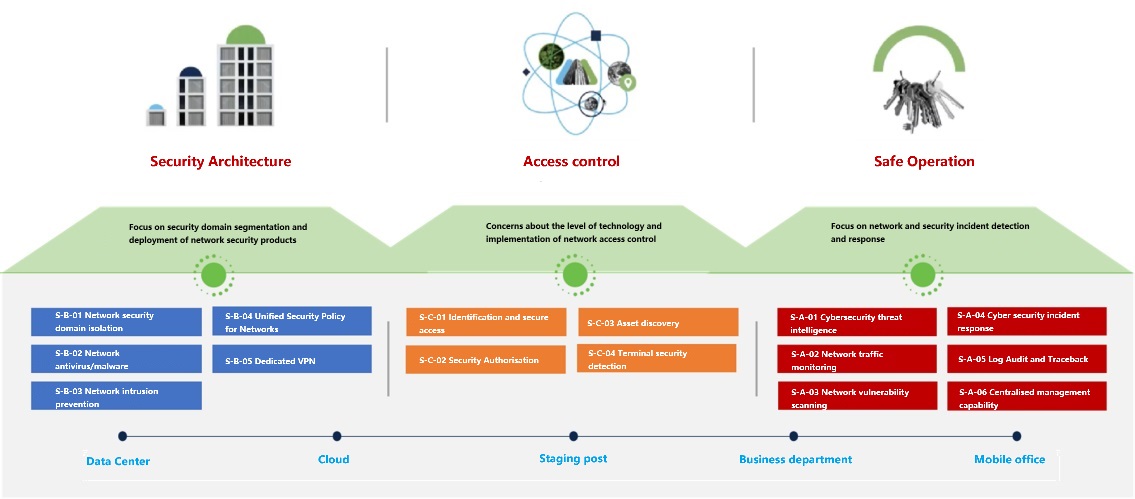Solution Background
As digitalization accelerates in the express delivery industry, a leading logistics client is facing multiple network security challenges and is seeking professional consulting services to optimize its network infrastructure.
-
• Outdated Equipment and Technology: The network devices have exceeded their service
life and lack adequate vulnerability remediation capabilities, making it difficult
to defend against ransomware and fileless attacks.
• Fragmented and Inefficient Architecture: The network devices have exceeded their
service life and lack adequate vulnerability remediation capabilities, making it
difficult to defend against ransomware and fileless attacks.
• Multi-Cloud Transition Needs: As the business transitions to multi-cloud and edge
computing, the current architecture lacks the flexibility to adapt. Application
access over the public network is poor, and traditional traffic control solutions
lack application-level awareness.
• Aging Infrastructure: The infrastructure in the Nanhui data center is beyond its
lifecycle and no longer supported by vendors, posing significant operational risks
and threatening business continuity.
Solution Overview
Leveraging a Zero Trust security architecture and Software-Defined Networking (SDN), the following core strategies are proposed:
- Architecture Upgrade: Establish unified network technology standards and consolidate four major business networks. Adopt active-active/multi-active network design to enhance availability. Deploy a cloud-network integrated architecture that supports multi-cloud and edge computing scenarios, enabling automated resource orchestration and flexible interconnectivity between headquarters and regional sites.
- Enhanced Security Capabilities: Introduce Zero Trust Access Control (SDP + micro-segmentation) to achieve "least privilege access everywhere" and block lateral movement risks. Deploy a unified security management platform to centralize asset management, configuration, logging, and threat detection (XDR) across network, endpoint, and cloud environments.
- Intelligent O&M Optimization: Improve public network performance using application-aware QoS and SD-WAN, enhancing the stability of sorting systems and industrial control equipment. Implement automated access control policies with dynamic identity authentication and fine-grained permission enforcement for external (BYOD) devices.
- Infrastructure Modernization: Upgrade the Nanhui data center into a cloud-enabled facility with hyper-converged infrastructure and redundancy design, ensuring a manageable and predictable device lifecycle.

Solution Advantages
- Zero Trust Architecture: Dynamic, identity- and device-based authorization that prevents both internal and external lateral movement, supporting complex scenarios such as BYOD and multi-cloud environments.
- Unified Security Management: Centralized management of assets, logs, and threat responses reduces blind spots and improves alert accuracy.
- Cloud-Network Synergy: SDN and SD-WAN enable multi-cloud interconnection and intelligent traffic orchestration, significantly shortening service rollout cycles.
- Application-Aware Networking: Intelligently prioritizes traffic from sorting and industrial control systems to ensure the stable transmission of critical business services.
- Automated Operations: Infrastructure-as-code enables automated orchestration of network resources and one-click policy deployment.
Customer Pain Points & Challenges
- Architectural & Security Deficiencies: Poor network isolation increases the risk of single points of failure and limits cross-region disaster recovery capabilities. A heterogeneous mix of device brands and the absence of centralized monitoring lead to inefficient asset management. Industrial control systems have been hit by virus attacks (e.g., CPU spikes and crashes), while sorting devices have experienced service disruptions caused by network threats.
- Access & Compliance Risks: The lack of a unified access policy for external endpoints makes it difficult to identify and block malicious devices. Incomplete security operations and log management hinder compliance with data regulations.
- Infrastructure Bottlenecks: Nanhui data center equipment is outdated and unsupported, posing high stability risks. Traditional data centers fall short in meeting the scalability and automation demands of cloud transformation.

Customer Benefits
- Enhanced Security Capabilities: Expanded protection coverage against ransomware and fileless attacks. End-to-end micro-segmentation reduces the risk of business interruption in industrial control and sorting systems.
- Efficiency & Cost Optimization: A 50% reduction in invalid alerts, with threat response time reduced from hours to minutes. Cloud-network architecture reduces dependency on leased lines, cutting network O&M costs.
- Compliance & Business Continuity: Ensures compliance with regulatory standards such as MLPS 2.0 and GDPR, with controllable data privacy risks. Active-active data center design improves availability and minimizes downtime.
- Future Scalability: Supports rapid edge node access and elastic multi-cloud resource expansion to accommodate business growth over the next five years.
By implementing Zero Trust and cloud-network convergence architectures, enterprises can enhance security, efficiency, and cost-effectiveness, accelerating the shift from infrastructure operations to intelligent service delivery.